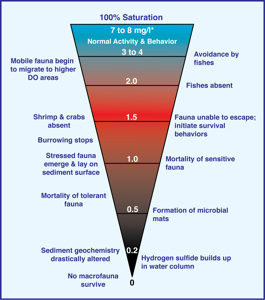VIMS dead-zone report card reflects extended season
Extent of Chesapeake Bay hypoxia in 2021 about average, but duration relatively long
The annual report of “dead-zone” conditions in the Chesapeake Bay from William & Mary's Virginia Institute of Marine Science indicates the overall severity of hypoxia was slightly higher than usual during 2021, due largely to the relatively early onset and late termination of low-oxygen waters.
“Even though we saw about average levels of hypoxia through the summer, the bay experienced more total hypoxia than normal this year because low-oxygen conditions started relatively early in the spring and lasted longer into fall,” says Marjy Friedrichs, a VIMS professor and report card co-author.

Both methodologies suggest a near-average-sized dead zone for this year, with VIMS’ model simulations indicating a dead zone slightly larger than average in 2021, and field data from the monitoring cruises suggesting a dead zone slightly smaller than average. These assessments confirm a spring 2021 forecast of a slightly smaller than average dead zone based on a statistical model developed by the University of Michigan.
“The general agreement between the multiple methods used to assess the size of this summer’s dead zone is reassuring,” says Friedrichs. “The relatively average dead-zone size, despite warming summer temperatures, is a testament to the success of management actions that have reduced nutrients entering the bay.”

Details of the VIMS report card — one component of Friedrichs and Bever's Chesapeake Bay Environmental Forecast System or CBEFS — are available in a two-page pdf document. Also available is the Chesapeake Bay Program’s press release announcing the 2021 dead-zone metrics as reported by all monitoring program participants.















